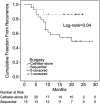Initial experience of sequential surgical epicardial-catheter endocardial ablation for persistent and long-standing persistent atrial fibrillation with long-term follow-up
- PMID: 21619988
- PMCID: PMC3117201
- DOI: 10.1016/j.athoracsur.2011.02.045
Initial experience of sequential surgical epicardial-catheter endocardial ablation for persistent and long-standing persistent atrial fibrillation with long-term follow-up
Abstract
Background: Patients with long-standing persistent (LSP) atrial fibrillation (AF) who have previously undergone catheter ablation represent a challenging patient population. Repeat catheter ablation in these patients is arduous and associated with a high failure rate, whereas surgical ablation can be complicated by multiple flutters. We sought to determine if minimally-invasive surgical ablation, followed by catheter ablation of all inducible flutters, would improve success rates over repeat catheter ablation alone.
Methods: Fifteen patients (Sequential) with persistent or LSP AF who failed at least one catheter ablation and one anti-arrhythmic drug (AAD) underwent surgical ablation, followed by planned endocardial evaluation and catheter mapping with ablation during the same hospitalization. Sequential patients were matched to 30 patients who had previously failed at least one catheter ablation and underwent a repeat catheter ablation (catheter-alone). The primary end point was event-free survival of any documented AF recurrence or AAD use.
Results: All patients underwent uncomplicated surgical ablation and electrophysiology procedure. Five Sequential patients had seven inducible flutters that were mapped and ablated. After a mean follow-up of 20.7±4.5 months, 13/15 (86.7%) Sequential patients, but only 16/30 (53.3%) catheter-alone patients, were free of any atrial arrhythmia and off of AAD (p=0.04). On AAD, 14/15 (93.3%) Sequential patients were free of any atrial arrhythmia recurrence, compared to 17/30 (56.7%) catheter-alone patients (p=0.01).
Conclusions: For patients with atrial fibrillation who have failed catheter ablation, Sequential minimally invasive epicardial surgical ablation, followed by endocardial catheter-based ablation, has a higher early success rate than repeat catheter ablation alone.
Copyright © 2011 The Society of Thoracic Surgeons. Published by Elsevier Inc. All rights reserved.
Figures






Comment in
-
Sequential hybrid ablation for persistent atrial fibrillation.Ann Thorac Surg. 2012 Aug;94(2):689-90; author reply 690. doi: 10.1016/j.athoracsur.2012.01.034. Ann Thorac Surg. 2012. PMID: 22818327 No abstract available.
References
-
- Haissguerre M, Hocini M, Sanders P, et al. Catheter ablation of long-lasting persistent atrial fibrillation: clinical outcome and mechanisms of subsequent arrhythmias. J Cardiovasc Electrophysiol. 2005;16:1138–47. - PubMed
-
- Jaïs P, Cauchemez B, Macle L, et al. Catheter ablation versus antiarrhythmic drugs for atrial fibrillation. The A4 study. Circulation. 2008;118:2498–505. - PubMed
-
- Zhou JSB, Edwards J, Jackman WM, Lazzara R, Po SS. Gradients of atrial refractoriness and inducibility of atrial fibrillation due to stimulation of ganglionated plexi. J Cardiovasc Electrophysiol. 2007;18:83–90. - PubMed
-
- Pak HN, Hwang C, Lim HE, Kim JS, Kim YH. Hybrid epicardial and endocardial ablation of persistent or permanent atrial fibrillation: a new approach for difficult cases. J Cardiovasc Electrophysiol. 2007;18:917–23. - PubMed
-
- Tan AY, Chou CC, Zhou S, et al. Electrical connections between left superior pulmonary vein, left atrium, and ligament of Marshall: implications for mechanisms of atrial fibrillation. Am J Physiol Heart Circ Physiol. 2006;290:H312–H22. - PubMed
Publication types
MeSH terms
Grants and funding
LinkOut - more resources
Full Text Sources
Medical

